There are pics today. Our hotel served what would have been a so-so dinner last night, except that they served a world-class pizza. We had a rough start today. The heat in the hotel doesn’t work. We asked and were given an electric space heater. This device can raise the temperature of the room from 16 to 17 in an hour and a half. (That’s 61 to 63 in Fahrenheit.) But we can stand in front of it to warm up. Plus, it’s the brightest light in the room, so we can see stuff when we want to.
We had to turn it off overnight, but the room comes with double heavy duty quilts. I woke at 5 the next morning as usual, but Danita slept in until it was time to get ready for breakfast. When she got up, she was feeling pretty bad, with a headache and various miscellaneous maladies. I went to take a shower, only to find there was no hot water. We went down to breakfast to find the best food available was a plate of bread that was placed on one of the tables, with some butter and jam. The only hot drink was coffee with a lot of sugar and a lot of cream.
Things got a lot better once we got on the bus. Our first visit was to Jokhang Temple, the largest and most important Buddhist temple in Tibet. Pics of the Jokhang Temple have captions that start with “JT: “. The interest started before we even got inside, with two of the biggest incense burners I have ever seen. Once a year, all the Monks get together for a week. They need lots of tea with yak butter. So they have a huge cauldron for makinging in. The rest of the year, it’s just decorative.
There were pilgrims all over the place. They were prostrating themselves, spinning prayer wheels, reciting prayers or songs while counting with a rosary, or offering money at the various statues and other points of religious significance. Did you know there are about 3,000 Buddhas? Primary Buddhas are First Buddha, Present Buddha, Future Buddha, Compassionate Buddha … there’s a very long list.
As before, pictures are not allowed inside the temple. But we were able to take pictures in the courtyard. They maintain special places for the Deli Lama to participate in their important ceremonies, even though the current Deli Lama is exiled, and there will probably never be another one.
There’s also an upstairs garden where we could take pictures. It’s difficult to get details of a lot of things because of the extremely bright sunlight. Interesting things are often in the shade, but surrounded by very bright sunlight. My cell phone camera can’t handle that kind of lighting.
Finally, here’s a picture of a Monk in the garden. I don’t know what these guys do all day long, but the few I saw were busy running from one place to another every time I saw them.
Our next stop was a very good lunch, followed by a lecture about Tibetan medicine. I was surprised that Tibetan medicine is much different than Chinese medicine. We learned quite a bit about it. Our lecture was in the traditional medicine hospital, which was filthy. I hope their resident rooms and operating areas are a lot cleaner. We were there during lunch break, so the only person we saw there were a couple of maintenance people and the man who gave the lecture.
They were describing how patents chose the doctor they wanted to see. Their description made me ask if patients can make appointments. They can’t. They just show up. If they can’t see the doctor that day, they can come back another day. One of the other people in our party asked about the availability of Western medical equipment. That’s when we learned that the hospital will sometimes do surgery, which uses mostly Western practices. And that they sometimes use Western diagnostic equipment to “correct” the diagnosis of the traditional doctor. Here’s a picture of the healing Buddha. It’s the first Buddha I saw where I was permitted to take a picture.
Our last touring stop was Sera Monastery. These pictures are prefixed with “SM: “. This is the largest and most important Buddha monastery in Tibet. Just before the cultural revolution, it had 4,000 monks. Today, it has 500 monks. My first picture is outside the monastery. It’s the first picture I have that shows how brown the surrounding mountains are.
No Buddha facility is complete without prayer wheels. I was able to take a picture of these. Remember: always rotate your Buddha prayer wheel clockwise, never counter-clockwise!
This is a picture of the Buddha circle of life. It is held by the god of death. After life, everybody who is not yet enlightened has to go to hell, where there is no light, and walk in the darkness until they are reincarnated. Burning yak butter will give these poor souls a little light. That’s why another thing one can find in any Buddha facility is several large tubs of burning yak butter.
The most interesting part of our visit (that I could photograph) is the monk debates. Monks educate themselves by reading scripture in the morning. Their lessons are reinforced with debates. The sitting monk is asking questions. The standing monk is answering them. After every answer, monks slap their wrist. The nerve in the wrist is connected to the brain. The slap improves the memory.
My final picture is of foreigner picture taking. Both Chinese and Tibetans like to ask Americans to pose with them in a picture. The protocol is that once the picture is taken, they thank us and walk away. But this time, I broke protocol and asked them to take the picture with my camera, so I can have a picture of us posing with them.
Well, if you got this far, I guess this post wasn’t too long. It’s about time to get ready for dinner.

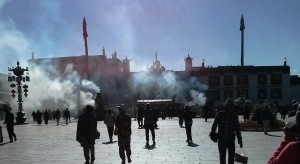
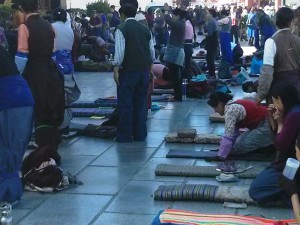
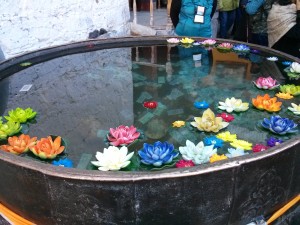
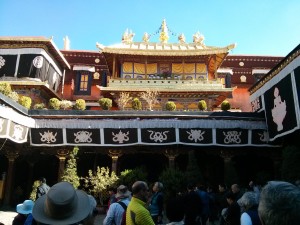
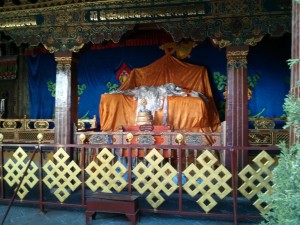

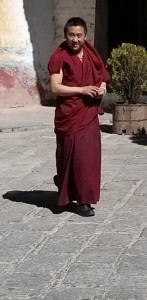
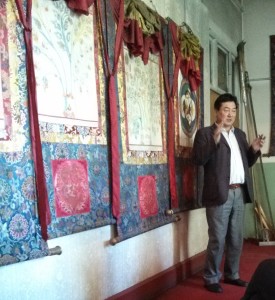

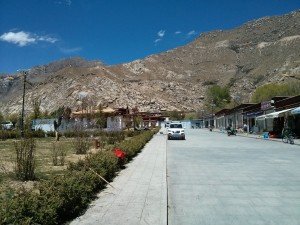
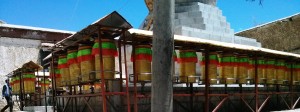

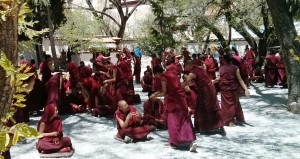
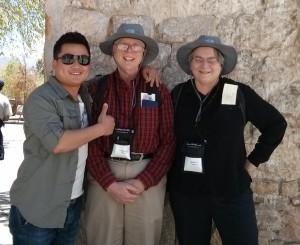
I’ve never known you to be to open-minded. Since I will probably never go to China or Tibet, I thank you for sharing your trip with me. Have fun and be careful
(Mom was sommewhat concerned that where you are may have been affected by the earthquake in Nepal.Maybe you could let her know how that is effecting you.)
Love,
Rick